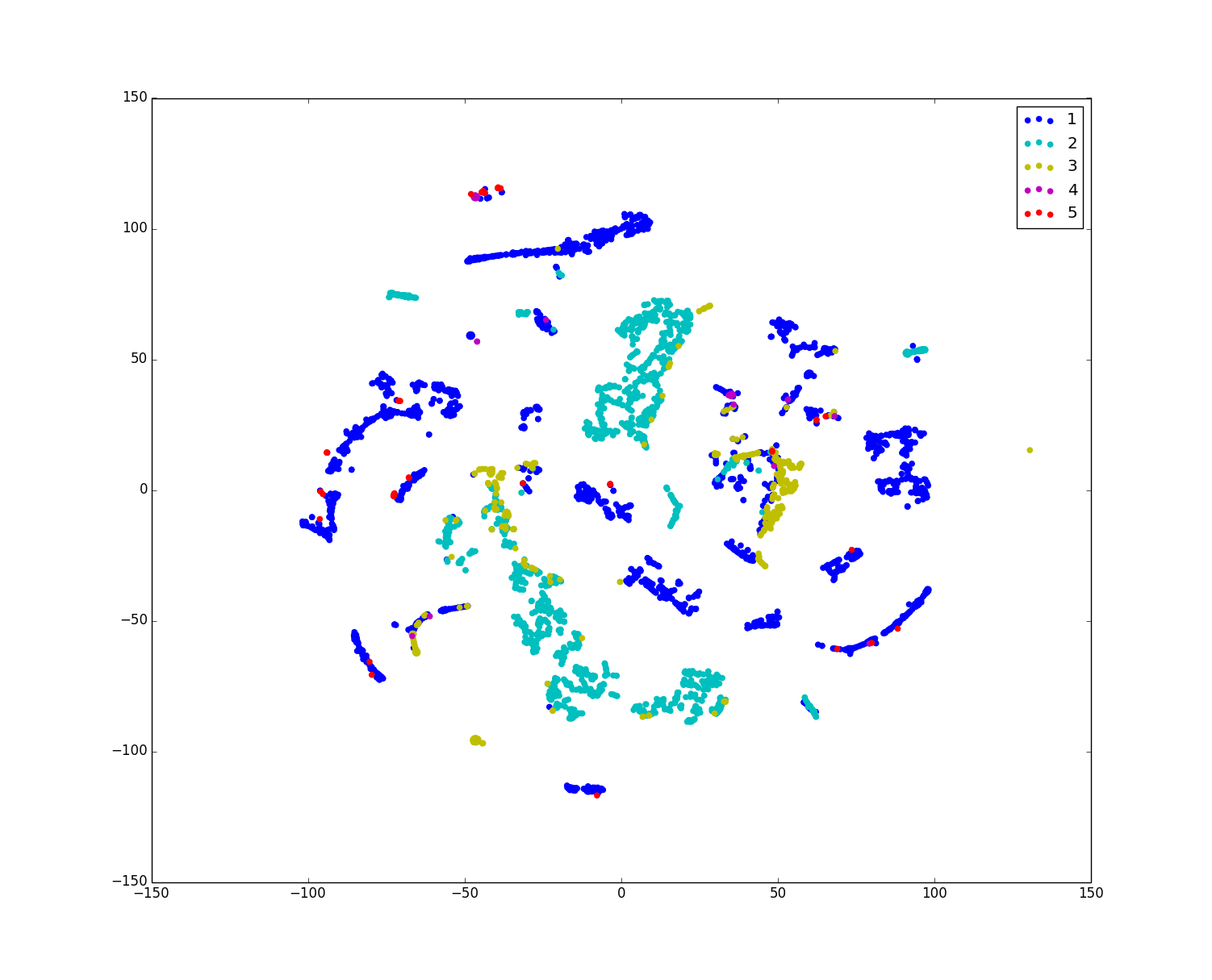
Python代码:准备训练样本的数据和标签:train_X4000.txt、train_y4000.txt 放于tsne.py当前目录.(具体t-SNE – Laurens van der Maaten http://lvdmaaten.github.io/tsne/,Python implementation),
tsne.py代码:(为了使得figure显示数据的标签,代码做了简单修改)
#!/usr/bin/env python
# -*- coding: utf-8 -*-
#
# tsne.py
#
# Implementation of t-SNE in Python. The implementation was tested on Python 2.5.1, and it requires a working
# installation of NumPy. The implementation comes with an example on the MNIST dataset. In order to plot the
# results of this example, a working installation of matplotlib is required.
# The example can be run by executing: ipython tsne.py -pylab
#
#
# Created by Laurens van der Maaten on 20-12-08.
# Copyright (c) 2008 Tilburg University. All rights reserved.
import numpy as Math
import pylab as Plot
def Hbeta(D = Math.array([]), beta = 1.0):
"""Compute the perplexity and the P-row for a specific value of the precision of a Gaussian distribution."""
# Compute P-row and corresponding perplexity
P = Math.exp(-D.copy() * beta);
sumP = sum(P)+1e-6;
H = Math.log(sumP) + beta * Math.sum(D * P) / sumP;
P = P / sumP;
return H, P;
def x2p(X = Math.array([]), tol = 1e-5, perplexity = 30.0):
"""Performs a binary search to get P-values in such a way that each conditional Gaussian has the same perplexity."""
# Initialize some variables
print "Computing pairwise distances..."
(n, d) = X.shape;
sum_X = Math.sum(Math.square(X), 1);
D = Math.add(Math.add(-2 * Math.dot(X, X.T), sum_X).T, sum_X);
P = Math.zeros((n, n));
beta = Math.ones((n, 1));
logU = Math.log(perplexity);
# Loop over all datapoints
for i in range(n):
# Print progress
if i % 500 == 0:
print "Computing P-values for point ", i, " of ", n, "..."
# Compute the Gaussian kernel and entropy for the current precision
betamin = -Math.inf;
betamax = Math.inf;
Di = D[i, Math.concatenate((Math.r_[0:i], Math.r_[i+1:n]))];
(H, thisP) = Hbeta(Di, beta[i]);
# Evaluate whether the perplexity is within tolerance
Hdiff = H - logU;
tries = 0;
while Math.abs(Hdiff) > tol and tries < 50:
# If not, increase or decrease precision
if Hdiff > 0:
betamin = beta[i].copy();
if betamax == Math.inf or betamax == -Math.inf:
beta[i] = beta[i] * 2;
else:
beta[i] = (beta[i] + betamax) / 2;
else:
betamax = beta[i].copy();
if betamin == Math.inf or betamin == -Math.inf:
beta[i] = beta[i] / 2;
else:
beta[i] = (beta[i] + betamin) / 2;
# Recompute the values
(H, thisP) = Hbeta(Di, beta[i]);
Hdiff = H - logU;
tries = tries + 1;
# Set the final row of P
P[i, Math.concatenate((Math.r_[0:i], Math.r_[i+1:n]))] = thisP;
# Return final P-matrix
print "Mean value of sigma: ", Math.mean(Math.sqrt(1 / beta))
return P;
def pca(X = Math.array([]), no_dims = 50):
"""Runs PCA on the NxD array X in order to reduce its dimensionality to no_dims dimensions."""
print "Preprocessing the data using PCA..."
(n, d) = X.shape;
X = X - Math.tile(Math.mean(X, 0), (n, 1));
(l, M) = Math.linalg.eig(Math.dot(X.T, X));
Y = Math.dot(X, M[:,0:no_dims]);
return Y;
def tsne(X = Math.array([]), no_dims = 2, initial_dims = 50, perplexity = 30.0):
"""Runs t-SNE on the dataset in the NxD array X to reduce its dimensionality to no_dims dimensions.
The syntaxis of the function is Y = tsne.tsne(X, no_dims, perplexity), where X is an NxD NumPy array."""
# Check inputs
if X.dtype != "float64":
print "Error: array X should have type float64.";
return -1;
#if no_dims.__class__ != "": # doesn't work yet!
# print "Error: number of dimensions should be an integer.";
# return -1;
# Initialize variables
X = pca(X, initial_dims).real;
(n, d) = X.shape;
max_iter = 1000
initial_momentum = 0.5;
final_momentum = 0.8;
eta = 500;
min_gain = 0.01;
Y = Math.random.randn(n, no_dims);
dY = Math.zeros((n, no_dims));
iY = Math.zeros((n, no_dims));
gains = Math.ones((n, no_dims));
# Compute P-values
P = x2p(X, 1e-5, perplexity);
P = P + Math.transpose(P);
P = P / (Math.sum(P));
P = P * 4; # early exaggeration
P = Math.maximum(P, 1e-12);
# Run iterations
for iter in range(max_iter):
# Compute pairwise affinities
sum_Y = Math.sum(Math.square(Y), 1);
num = 1 / (1 + Math.add(Math.add(-2 * Math.dot(Y, Y.T), sum_Y).T, sum_Y));
num[range(n), range(n)] = 0;
Q = num / Math.sum(num);
Q = Math.maximum(Q, 1e-12);
# Compute gradient
PQ = P - Q;
for i in range(n):
dY[i,:] = Math.sum(Math.tile(PQ[:,i] * num[:,i], (no_dims, 1)).T * (Y[i,:] - Y), 0);
# Perform the update
if iter < 20:
momentum = initial_momentum
else:
momentum = final_momentum
gains = (gains + 0.2) * ((dY > 0) != (iY > 0)) + (gains * 0.8) * ((dY > 0) == (iY > 0));
gains[gains < min_gain] = min_gain;
iY = momentum * iY - eta * (gains * dY);
Y = Y + iY;
Y = Y - Math.tile(Math.mean(Y, 0), (n, 1));
# Compute current value of cost function
if (iter + 1) % 10 == 0:
C = Math.sum(P * Math.log(P / Q));
print "Iteration ", (iter + 1), ": error is ", C
# Stop lying about P-values
if iter == 100:
P = P / 4;
# Return solution
return Y;
if __name__ == "__main__":
print "Run Y = tsne.tsne(X, no_dims, perplexity) to perform t-SNE on your dataset."
print "Running example on 2,500 MNIST digits..."
X = Math.loadtxt("train_X4000.txt");
#X = X[:100]
labels = Math.loadtxt("train_y4000.txt");
#labels = labels[:100]
Y = tsne(X, 2, 38, 20.0);
fil = open('Y.txt','w')
for i in Y:
fil.write(str(i[0])+' '+str(i[1])+'
')
fil.close()
colors=['b', 'c', 'y', 'm', 'r']
idx_1 = [i1 for i1 in range(len(labels)) if labels[i1]==1]
flg1=Plot.scatter(Y[idx_1,0], Y[idx_1,1], 20,color=colors[0],label='1');
idx_2= [i2 for i2 in range(len(labels)) if labels[i2]==2]
flg2=Plot.scatter(Y[idx_2,0], Y[idx_2,1], 20,color=colors[1], label='2');
idx_3= [i3 for i3 in range(len(labels)) if labels[i3]==3]
flg3=Plot.scatter(Y[idx_3,0], Y[idx_3,1], 20, color=colors[2],label='3');
idx_4= [i4 for i4 in range(len(labels)) if labels[i4]==4]
flg4=Plot.scatter(Y[idx_4,0], Y[idx_4,1], 20,color=colors[3], label='4');
idx_5= [i5 for i5 in range(len(labels)) if labels[i5]==5]
flg5=Plot.scatter(Y[idx_5,0], Y[idx_5,1], 20, color=colors[4],label='5');
# flg=Plot.scatter(Y[:,0], Y[:,1], 20,labels);
Plot.legend()
Plot.savefig('figure4000.pdf')
Plot.show()